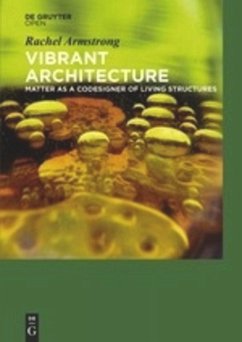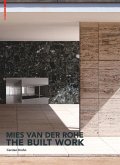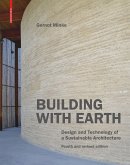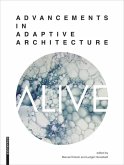This book sets out the conditions in which the need for a new approach to the production of architecture in the twenty-first century is established, where our homes and cities are facing increasing pressures from environmental challenges that are compromising our well being and our lives. Vibrant architecture embodies a new kind of architectural design practice that explores how lively materials, or ‘vibrant matter’ may be incorporated into our buildings to confer on them some of the properties of living things such as, movement, growth, sensitivity and self-repair. My research examines the theoretical and practical implications of how this may occur through the application of a new group of materials in the production of our living spaces, collectively referred to as ‘vibrant matter’. Characteristically, these substances possess some of the properties of living systems but may not have the full status of being truly ‘alive’ and include forms of chemical ‘artificial’ life such as ‘dynamic droplets’, or synthetically produced soils. These complex systems are able to directly communicate with the natural world using a shared language of chemistry and so negotiate their continued survival in a restless world. These chemical conversations may become a design strategy by applying the principles of an emerging scientific field called ‘natural computing’, which shares Alan Turing’s interest in the computational powers of Nature. Natural computing shapes the outcomes of vibrant matter and offers a range of new tools for design through a new technical operating system identified as an ‘assemblage’. Assemblages provide a unique set of associated concepts, operating principles and outcomes that are qualitatively distinct from those of machines. A range of design projects that demonstrate the principles of a new approach to the choreography of space are explored through the construction of spatial programs and formulating design tactics in projects such as the Hylozoic Ground installation, a collaboration with architect Philip Beesley for the 2010 Venice Architecture Biennale. Further experimental and speculative development of the assemblage operating system is explored through additional design work in 'Vibrant Venice', which proposes to grow an artificial limestone reef underneath the foundations of the city. Urban-scale outcomes are also explored in 'Vibrant cities', which applies synthetic soils as a material and technological strategy that optimises environmental performance in under used and poorly imagined sites within urban environments. Collectively, these technical and design studies suggested that the theory and practice of vibrant matter may give rise to new kinds of material solutions within the practice of the built environment, which could be applied to architectural design as 'vibrant architecture', which is stochastic and life-promoting – and stands in stark contrast to the prevalent view of sustainable practices, which are centred on an industrial approach to resource conservation. Vibrant architecture may create new opportunities for architectural design practice that venture beyond top-down form-finding programs, by enabling architects to codesign in partnership with human and nonhuman collectives, which result in the production of post natural landscapes. Ultimately, vibrant architecture may operate as an ecological platform for human development that augments the liveliness of our planet, rather than diminishes it.
"Only a true visionary could cook up this monstrous, yet glamorous hybrid of architecture and chemistry. Dr. Armstrong has plenty to say about her creative work here, and an erudite, dazzling set of references at the end of her book. It's like a cultural sensibility in a gelatin capsule."
Bruce Sterling, science fiction writer, best known for his novels and his work on the Mirrorshades anthology. Leading figure of the cyberpunk genre.
"Armstrong's theories are unique and instrumentally productive. This volume is the consequence of numerous years of inquiry and is a masterwork for a new architecture at the brink of life itself. It is, undeniably, one of the most outstanding texts I have read in the field in the last decade."
Professor Mitchell Joachim, New Lab, New York University, and Co-Founder Terreform ONE
"Rachel Armstrong is a true visionary, a radiant original whose daring and ground-breaking thesis lays out the core ecological concepts of a broader programme to explore the potential of experimental design work for the 21st century. Many talk of "disruptive innovation" - Rachel Armstrong is, in my view, its foremost and most brilliant spokesperson, operating on another level of complexity to what passes for 'radical thinking' in too many of our universities, design studios and think tanks."
Professor Rolf Hughes, Head of Research, Stockholm University of the Arts, Vice President Society for Artistic Research (2011-2015)
"Rachel Armstrong's Vibrant Architecture delivers no less than theoretical and practical foundations for an evolutionary design science that would build in accordance with nature's biorhythms. To appreciate the significance of this book, one would need to go back fifteen years to Stephen Wolfram's A New Kind of Science, which tried to model the entire universe in terms of the cellular automata that underwrite modern computers. While the spirit that informs Rachel Armstrong's Vibrant Architecture is decidedly different - and even opposed - to Wolfram's, nevertheless a similar ambition of potentially cosmic scope is on display here. In Armstrong's case, the Bütschli droplet is the elementary particle of an evolutionary design science that would build in accordance with nature's biorhythms. If nothing else, this book should silence those skeptical of the practical payoff of the 'new materialism' nowadays popular in postmodern circles."
Professor Steve Fuller, Auguste Comte Chair of Social Epistemology, University of Warwick
"Rachel Armstrong's ground-breaking 'Vibrant Architecture' offers fundamentally new paradigms for architectural design. With meticulous scholarship underpinned by close readings from contemporary philosophy and architectural practice, Armstrong sets out a compelling vision for complex, subtle, sensitive, and above all fertile architecture of the future. Armstrong demonstrates vividly that we are embedded in a web of mutual influences without boundaries between human and non-human, organic and inorganic. The remarkable optimism of her thesis is underpinned by rigorous readings from multiple disciplines including advanced physics, chemistry, biology, material science and cybernetics."
Professor Philip Beesley, architect, electronic artist, publisher and Director of the Living Architecture Systems Group, University of Waterloo, Toronto
"Architecture is being redefined in its 'consistency', forcing architects to integrate with their buildings the inherited functions that vibrant matter represents on molecular scale. Rachel Armstrong's Vibrant Architecture opens debates about managing our environments: questioning concepts of durability or longevity and proposing for future architecture the familiar naturalistic strategies of dynamics, adaptability and metabolism. Only then can architecture become a new alive agent, in continuous dialogue with its environment and users."
Professor Areti Markopoulou, Academic Director at the Institute for Advanced Architecture of Catalonia and Co-Founder Studio P52, Barcelona
Bruce Sterling, science fiction writer, best known for his novels and his work on the Mirrorshades anthology. Leading figure of the cyberpunk genre.
"Armstrong's theories are unique and instrumentally productive. This volume is the consequence of numerous years of inquiry and is a masterwork for a new architecture at the brink of life itself. It is, undeniably, one of the most outstanding texts I have read in the field in the last decade."
Professor Mitchell Joachim, New Lab, New York University, and Co-Founder Terreform ONE
"Rachel Armstrong is a true visionary, a radiant original whose daring and ground-breaking thesis lays out the core ecological concepts of a broader programme to explore the potential of experimental design work for the 21st century. Many talk of "disruptive innovation" - Rachel Armstrong is, in my view, its foremost and most brilliant spokesperson, operating on another level of complexity to what passes for 'radical thinking' in too many of our universities, design studios and think tanks."
Professor Rolf Hughes, Head of Research, Stockholm University of the Arts, Vice President Society for Artistic Research (2011-2015)
"Rachel Armstrong's Vibrant Architecture delivers no less than theoretical and practical foundations for an evolutionary design science that would build in accordance with nature's biorhythms. To appreciate the significance of this book, one would need to go back fifteen years to Stephen Wolfram's A New Kind of Science, which tried to model the entire universe in terms of the cellular automata that underwrite modern computers. While the spirit that informs Rachel Armstrong's Vibrant Architecture is decidedly different - and even opposed - to Wolfram's, nevertheless a similar ambition of potentially cosmic scope is on display here. In Armstrong's case, the Bütschli droplet is the elementary particle of an evolutionary design science that would build in accordance with nature's biorhythms. If nothing else, this book should silence those skeptical of the practical payoff of the 'new materialism' nowadays popular in postmodern circles."
Professor Steve Fuller, Auguste Comte Chair of Social Epistemology, University of Warwick
"Rachel Armstrong's ground-breaking 'Vibrant Architecture' offers fundamentally new paradigms for architectural design. With meticulous scholarship underpinned by close readings from contemporary philosophy and architectural practice, Armstrong sets out a compelling vision for complex, subtle, sensitive, and above all fertile architecture of the future. Armstrong demonstrates vividly that we are embedded in a web of mutual influences without boundaries between human and non-human, organic and inorganic. The remarkable optimism of her thesis is underpinned by rigorous readings from multiple disciplines including advanced physics, chemistry, biology, material science and cybernetics."
Professor Philip Beesley, architect, electronic artist, publisher and Director of the Living Architecture Systems Group, University of Waterloo, Toronto
"Architecture is being redefined in its 'consistency', forcing architects to integrate with their buildings the inherited functions that vibrant matter represents on molecular scale. Rachel Armstrong's Vibrant Architecture opens debates about managing our environments: questioning concepts of durability or longevity and proposing for future architecture the familiar naturalistic strategies of dynamics, adaptability and metabolism. Only then can architecture become a new alive agent, in continuous dialogue with its environment and users."
Professor Areti Markopoulou, Academic Director at the Institute for Advanced Architecture of Catalonia and Co-Founder Studio P52, Barcelona








